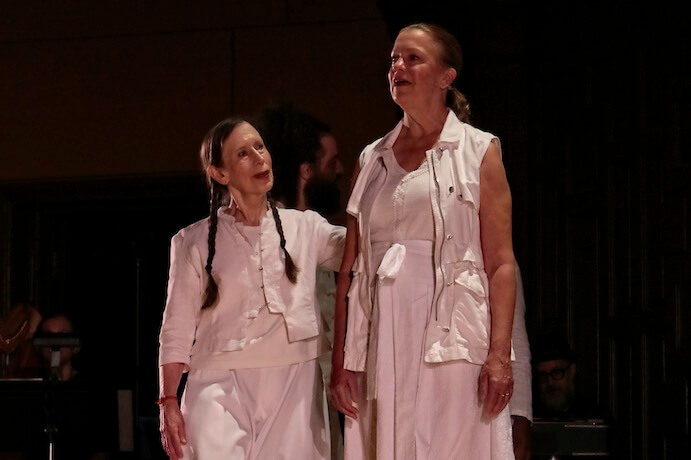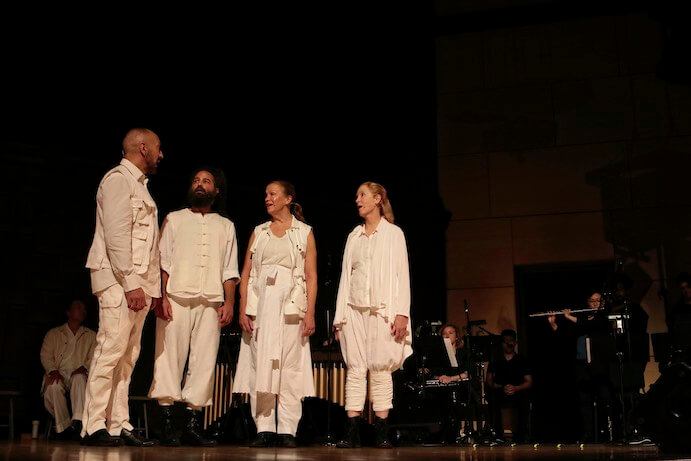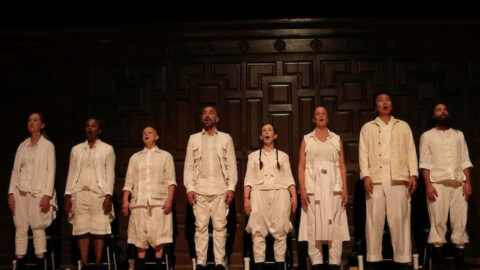In Buddhism and Hinduism, the deity Indra holds a large net of rope and multifaceted jewels, which represents the interconnectivity of all beings seeing themselves in one another. As a practicing Buddhist herself, Meredith Monk describes this metaphor as a teaching story passed from generation to generation — an oral tradition.
Over the course of Monk’s career, oral traditions have shaped her approach to composition and expanded the idea of what a “classical” musician can be. Largely eschewing printed music, she often teaches her works directly to performers, tailoring the expressive music and movement to each individual while still maintaining her own vision. These personal relationships, as well as a curiosity about religion, ecology, space, and place, have sustained Monk for six decades, giving her work a feeling of continued evolution and relevance.
Her newest work, Indra’s Net, premiered on November 12 and 13 at Mills College in Oakland, California. This production of the evening-length piece, originally set to premiere in 2020 and delayed due to COVID-19, was a concert-setting performed by Monk herself, members of her long-established ensemble (Meredith Monk and Vocal Ensemble), and musicians from the Bay area. Monk selected the intergenerational performing forces to add to the piece’s philosophical framework, representing human connection across a wide breadth of time and experience.

Even before Indra’s Net, Monk has drawn inspiration from big, humanistic questions that manifest in scale and scope. In her cinematic opera, Quarry (1976), Monk considers the second World War, fascism, and intolerance. In her first work resembling a more traditional opera (Atlas, 1991), she shows a woman navigating personal growth through enlightenment, community, and compassion.
Following On Behalf of Nature (2013) and Cellular Songs (2018), Indra’s Net completes a triptych that contemplates the ways humans relate to the Earth and to each other. Monk arranges Indra’s Net in three sets of smaller movements, many of which sonically explore different ideas of the jewels in the allegorical net. But among these sets, she also situates movements that address ideas about our world and how people in different societies relate to each other through sound and motion.
The piece opened with two orchestral movements (“Jewel 1” and “Jewel 2”), featuring interlocking melodies that worked together as the seven singers entered the stage. Dressed in all white, they sat facing the audience on stools between the sections of the orchestra — strings on one side of the stage, winds on the other. Each performer came into physical contact with the arms and legs of their neighbor, a physical manifestation of the net’s metaphor. After a brief section of only pantomimed touch, the performers grasped hands, showing the power of human connection over individual privilege. For the rest of the work, Monk’s choreography and music highlighted the potency and intensity of connection among humans and their world.

The musicians seem to represent the jewels in the titular net. Monk achieves this by connecting individual melodies — many of which are developed or transformed excerpts of music we have already heard, reflecting each other while also being unique musical material. At the beginning of the second set (“Melodies 2”), Gideon Crevoshay offered a rich and crisp tenor melody, and Katie Geissinger quickly followed in canon. Allison Sniffin entered and sang almost an inversion of the first melody, then Theo Bleckmann sang a repeating figure that contained smaller parts of earlier music. Monk tended to situate her own melody in the sonic median, with a more variant and complex figure. She also arranged instruments within the vocal soundscape, connecting the human voice with instruments in an exploration of timbres (a technique also found in some of her earlier works), often leaving the listener the pleasure of finding the source of each sound.
Still evolving her famous extended techniques, Monk asked the singers to clack their teeth together, pop their tongues, and use other mouth percussion in repeating two-bar phrases while simultaneously singing in the lighthearted “Teeth Song.” Percussionists John Hollenbeck and Tony Gennaro came center stage to join the singers, playing a variety of portable percussion instruments and adding a polyrhythmic layer to the singers’ music. The result was an expression of community via play and joy in connection.
Meredith Monk has once again presented an ambitious work full of musical intimacy, sensitivity, and compassion in Indra’s Net. The score largely reflects her trademark compositional language: repetition with constant change, textural density with clarity, and easy to listen to but also richly complex. The choreography asks all of the musicians to show ease, joy, and humanity while navigating difficult music and movement, and they deftly accomplished the task. As Monk continues to compose with interdisciplinary media, she gains inspiration from our present time, current social issues, and wider, philosophical questions.
I CARE IF YOU LISTEN is an editorially-independent program of the American Composers Forum, funded with generous donor and institutional support. Opinions expressed are solely those of the author and may not represent the views of ICIYL or ACF.
A gift to ACF helps support the work of ICIYL. For more on ACF, visit the “At ACF” section or composersforum.org.
























